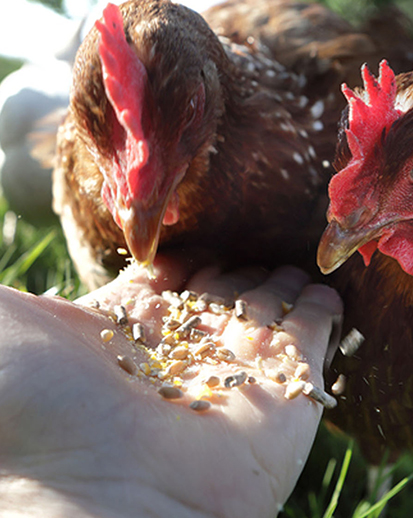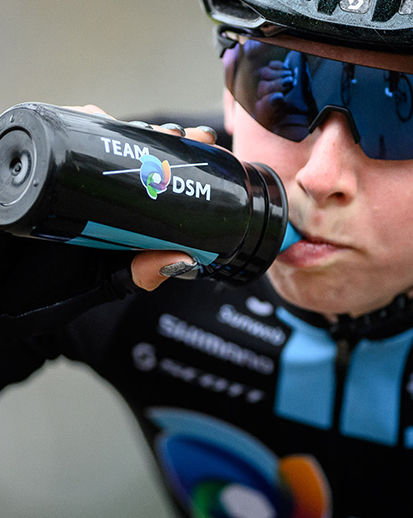Our approach to the Sustainable Development Goals
The UN Global Goals for Sustainable Development (SDGs)
In 2016, the United Nations launched the SDGs, a roadmap to a more environmentally and socially conscious and responsible world by 2030. At DSM, we believe that companies have a key role to play in achieving the SDGs. We believe that our combination of Health, Nutrition and Sustainable Living contributes toward achieving the SDGs
Working on the SDGs through our Focus Domains
With our unique science-based competences, we have created a strong platform for growth and are ideally positioned to contribute to, and capture the growth opportunities offered by, the global megatrends and SDGs, with a particular focus on developing innovative solutions addressing our Focus Domains of Nutrition & Health, Climate & Energy, and Resources & Circularity. Our purpose-led, performance-driven strategy is based on the global megatrends and SDGs.
Our Brighter Living Agenda brings together many of our initiatives and creates an actionable framework. It comprises three pillars:
Improve: we improve our own operations to do no harm. We optimize our own operational impact by continually raising safety standards, promoting health and well-being in our own workforce, reducing our emissions, increasing our use of renewable energy and unlocking more value from limited resources
Enable: we enable our customers to have a positive impact by creating products and services that enable our customers and partners to deliver sustainable and healthy solutions for the planet and society
Advocate: we advocate in our ecosystem for systemic change — we advocate for the future we believe in and we fully accept our responsibilities as a corporate member of society
Our purpose and three Focus Domains align most closely with five of the SDGs, and we show here how we approach these core SDGs. Information about our engagements can be found in the Sustainability statements and throughout this Report.
SDG 2 and SDG 3 through Nutrition & Health
The link between adequate nutrition and health has never been clearer. For the first time in human history, diet-related non-communicable diseases (including diabetes, heart disease, stroke, and some cancers) have overtaken communicable diseases as the primary cause of deaths worldwide. At the same time, malnutrition in its various forms affects more than 30% of the world’s population: more than 2.3 billion adults and children are obese or overweight, more than 820 million people go to bed hungry each night, and approximately two billion suffer from hidden hunger.
Our Nutrition & Health Commitments
- Together with the United Nations World Food Programme, we will raise awareness of improved nutrition while continuing to develop new food solutions
- We take responsibility to control and minimize all possible safety risks and adverse effects that could be caused by (the substances present in) our products throughout the value chain
- Together with Generation Unlimited and Sight and Life Foundation, we will develop a business plan in Africa to reach one million smallholder farmers by transforming the food system, providing better nutrition, stimulating youth job creation and reducing reliance on food imports
The Brighter Living Agenda for Nutrition & Health
Improve
By reducing occupational safety incidents and promoting health and well-being in our own workforce.
Enable
By enabling healthy diets for all, through solutions such as the sustainable production of animal proteins, plant-based choices, immunity-supporting solutions, and food & beverage solutions. Our biomedical solutions improve quality of life for surgical patients and improve people’s health status.
Advocate
For healthy diets within planetary boundaries, in partnerships to address sustainable and healthy nutrition through partners such as the World Business Council for Sustainable Development's FReSH program and the World Economic Forum, and in partnerships to fight malnutrition, such as the UN World Food Programme, UNICEF, World Vision and Scaling Up Nutrition.
Contributing to the Sustainable Development Goals
Our Nutrition & Health Focus Domain links to the following SDG targets:
- Target 2.1 By 2030, end hunger and ensure access by all people, in particular the poor and people in vulnerable situations, including infants, to safe, nutritious and sufficient food all year round
- Target 2.2 By 2030, end all forms of malnutrition, including achieving, by 2025, the internationally agreed targets on stunting and wasting in children under 5 years of age, and address the nutritional needs of adolescent girls, pregnant and lactating women and older persons
- Target 3.2 By 2030, end preventable deaths of newborns and children under 5 years of age, with all countries aiming to reduce neonatal mortality to at least as low as 12 per 1,000 live births and under-5 mortality to at least as low as 25 per 1,000 live births
- Target 3.4 By 2030, reduce by one-third premature mortality from non-communicable diseases through prevention and treatment and promote mental health and well-being
- Target 3.9 By 2030, substantially reduce the number of deaths and illnesses from hazardous chemicals and air, water and soil pollution and contamination
SDG 7 and SDG 13 through Climate & Energy
The stability of the world’s climate is under threat. We believe there is an urgent need to take action to curb climate change and its irreversibly damaging effects on biodiversity by dramatically limiting greenhouse gas emissions, transitioning to renewable energy, and adopting low-carbon emission solutions and processes.
The transition to a low-carbon economy will also create business opportunities and drive growth for our innovative and sustainable solutions. We are enabling the development of a low-carbon economy not just by reducing our own emissions but also by developing solutions to help customers and consumers to cut theirs.
Our Climate & Energy Commitments
- Our Science Based Targets comprising a scope 1 + 2 absolute reduction of 30% and a scope 3 intensity reduction of 28% by 2030 versus baseline 2016 toward our net zero emissions by 2050 commitment
- Supporting targets of an average annual energy efficiency improvement of >1% and 75% purchased electricity from renewable sources by 2030
- We apply an internal carbon price of €50/t CO2eq on our key investments, acquisitions and in our management reporting
The Brighter Living Agenda for Climate & Energy
Improve
Our long-term goal is net-zero emissions by 2050. To put us on track to achieve this, by 2030 we will reduce our own carbon footprint.
Scope 1 + 2 GHG emissions and improve the resiliency of our assets and supply chains. Our approach to resiliency and adaptation, including physical and transition risk assessments, is summarized in Taskforce on Climate-related Financial Disclosures (TCFD).
Enable
By enabling the low-carbon economy through solutions that help customers cut emissions and improve society’s ability to adapt to climate change. These include improving the sustainability of animal farming and engineering solutions for mobility and solutions for renewable energy.
Advocate
For climate action and building the movement for a low-carbon, resilient economy through cross domain initiatives such as the World Economic Forum and World Business Council for Sustainable Development, and leading climate platforms such as the Carbon Pricing Leadership Coalition, RE100 and GCA.
Contributing to the Sustainable Development Goals
- Target 7.2 By 2030, increase substantially the share of renewable energy in the global energy mix
- Target 7.3 By 2030, double the global rate of improvement in energy efficiency
- Target 13.2 Integrate climate change measures into national policies, strategies and planning
- Target 13.3 Improve education, awareness-raising and human and institutional capacity on climate change mitigation, adaptation, impact reduction and early warning
SDG 12 through Resources & Circularity
The world’s resources are finite, and with a population projected to grow to 9.7 billion people by 20501, some estimates suggest we will need the equivalent of four Planet Earths by then to sustain our current lifestyles2. In addition, over 30% of all food produced either lost or wasted, representing a huge drain on natural resources3. New ways of achieving a balance between demand and supply have to be found, including approaches that are not based on single use and subsequent disposal. We are making important contributions to the development of a genuinely circular, bio-based economy founded on closed-loop solutions.
Our Resources & Circularity Commitments
- We will offer a full portfolio of alternatives that contain at least 25% recycled- and/or bio-based content by 2030 in our Engineering Materials business
- Sixty percent of the feedstock used in our Dyneema products will be bio-based by 2030
- ‘Safe by design’ is the leading principle in the development of new and better products and processes
- Eighty to ninety percent of our waste will be recycled by 2020
- We will at least maintain our water efficiency while we work toward defining a context-based water target
- We will improve our VOC emission efficiency by 50% by 2021 (vs. 2015)
The Brighter Living Agenda for Resources & Circularity
Improve
By unlocking more value from the limited resources that are available. Water security and our impact on biodiversity are important aspects of our continuous improvement mindset. We minimize the use of substances of high concern where possible.
Enable
By enabling our customers to design safer and more circular end-products, and minimize the use of finite resources. These include our joint ventures Veramaris and Olatein, as well as bio-based and recycled-based solutions such as Akulon PA6 and Bio-based Dyneema® and the circular economy.
Advocate
For the transition from a linear to a circular and bio-based economy through global platforms such as the World Business Council for Sustainable Development, and circular economy platforms such as Platform for Accelerating the Circular Economy, Circular Economy and the Ellen MacArthur Foundation.
Contributing to the Sustainable Development Goals
- Target 12.2 By 2030, achieve the sustainable management and efficient use of natural resources
- Target 12.3 By 2030, halve per capita global food waste at the retail and consumer levels and reduce food losses along production and supply chains, including post-harvest losses
- Target 12.4 By 2020, achieve the environmentally sound management of chemicals and all wastes throughout their life cycle, in accordance with agreed international frameworks, and significantly reduce their release to air, water and soil in order to minimize their adverse impacts on human health and the environment
- Target 12.5 By 2030, substantially reduce waste generation through prevention, reduction, recycling and reuse
Our contribution across the SDGs
Our purpose-led, performance driven strategy is based on global megatrends and the SDGs. We align our approach of our Focus Domains with five ‘core’ SDGs: SDG 2 and SDG 3 through Nutrition & Health, SDG 7 and SDG 13 through Climate & Energy and SDG 12 through Resources & Circularity. In addition to these ‘core’ SDGs, we believe that we can also Improve, Enable and Advocate to a varying extent across all the SDGs. Below we indicate our estimated contribution in respect of all the SDGs.
Primary energy is energy that has not yet been subjected to a human engineered conversion process. It is the energy contained in unprocessed fuels.
Final (consumed) energy is the energy that is consumed by end-users. The difference between primary energy and final consumed energy is caused by the conversion process between the two as well as any transmission losses.
Scope 1: Direct GHG emissions
Direct GHG emissions occur from sources that are owned or controlled by the company (i.e., emissions from combustion in owned or controlled boilers, furnaces, vehicles, etc.).
Scope 2: Indirect GHG emissions
Indirect GHG emissions relate to the generation of purchased energy (i.e., electricity, heat or cooling) consumed by the company. Purchased energy is defined as energy that is purchased or otherwise brought into the organizational boundary of the company. Scope 2 emissions physically occur at the facility where the energy is generated.
Scope 3: Value chain emissions
Scope 3 emissions are all indirect emissions (not included in scope 2) that occur in the value chain of the reporting company, including both upstream and downstream emissions.
Location-based emissions
Reflects the average GHG emissions intensity of grids on which electricity consumption occurs (using mostly national grid-average emission factor data). Corresponding emission factor: in most cases, the country emission factor.
Market-based emissions
Reflects GHG emissions from electricity supplies that companies have purposely chosen (or their lack of choice) and contracted. Corresponding emission factors:
- Supplier specific emission factor (provided by the supplier)
- Residual emission factor (country-based grid factor, corrected for allocated purchased electricity from renewable resources)







